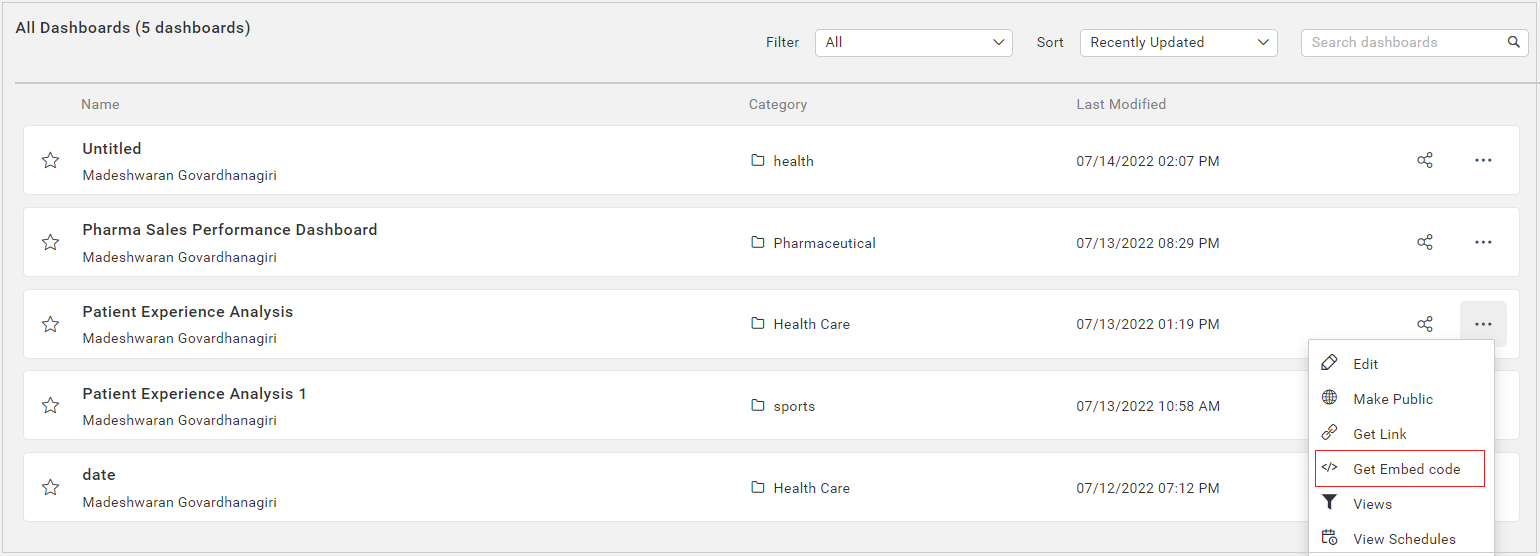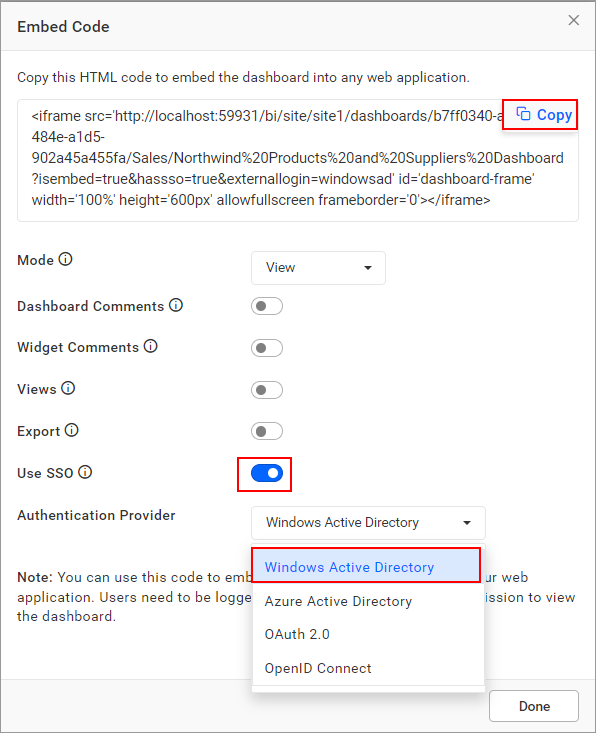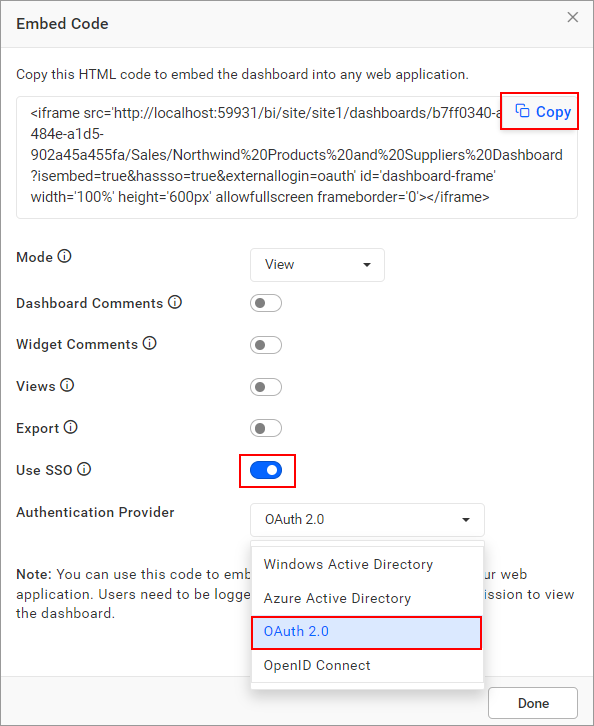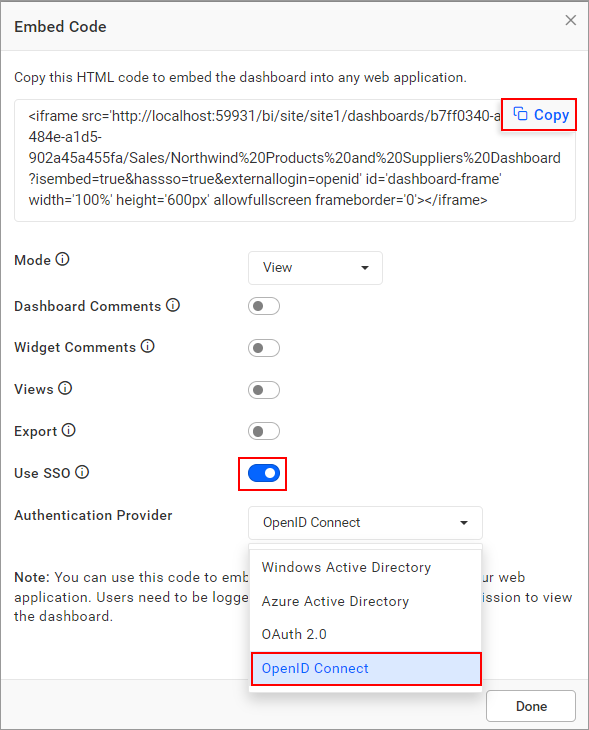Embed Dashboards using external SSO authentication
Bold BI supports embedding the dashboards into other web applications using external Single Sign-On authentication in the iframe-based embedding. The Bold BI application can be configured to support Windows Active Directory, Azure Active Directory, OAuth 2.0, and OpenID Connect authentications.
Embed using Windows AD Authentication
The Bold BI application has been configured with the Windows Active Directory. The following steps demonstrate how to obtain the embed code using the Windows Active Directory SSO settings. Learn more about configuring Windows Active Directory settings.
-
Please click on the context menu of the corresponding dashboard and select the
Get Embed codeoption.
-
In the Embed Code dialog box, choose
Viewas the mode. Then, enable theSSOand select theWindows Active Directoryoption, as shown in the image below.
-
Copy the embed URL by clicking the
copyicon from the Embed Code dialog and paste it into a web application that has configured the Windows Active Directory. -
To use the web application, please run it and sign in with your Windows Active Directory credentials. Once signed in, the dashboard will automatically display based on the permissions assigned to your Windows user account.
Embed using Azure AD Authentication
The Bold BI application has been configured with the Azure Active Directory. The following steps show how to get the embed code with the Azure Active Directory SSO settings. Learn more about the configure Azure Active Directory settings.
-
Click on the context menu of the corresponding dashboard and select the option
Get Embed code.
-
In the Embed Code dialog box, select
Viewas the mode.SSOfeature and chooseAzure Active Directory, as demonstrated in the image below.
-
To copy the embed URL, click the
copyicon in the Embed Code dialog, and then paste it into a web application that has configured the Azure Active Directory. -
To access the web application, sign in with Azure Active Directory. Once signed in, the dashboard will automatically render based on the user’s permissions in Azure.
Embed using OAuth 2.0 Authentication
The Bold BI application has been configured with the OAuth 2.0. The following steps show how to get the embed code with the OAuth SSO settings. Learn more about the configure OAuth 2.0 settings.
-
Click the context menu of the respective dashboard and choose the
Get Embed codeoption.
-
In the Embed Code dialog box, select mode as
View. Enable theSSOand select theOAuth 2.0option as shown in the following image.
-
To copy the embed URL, click on the
copyicon in the Embed Code dialog. Then, paste the URL into a web application that has configured OAuth 2.0 authentication. -
To properly run the web application, sign in with the configured OAuth provider. Once signed in, the dashboard will automatically render based on the permissions granted to the OAuth user.
Embed using OpenID Connect Authentication
The Bold BI application has been configured with OpenID Connect. The following steps demonstrate how to obtain the embed code using the OpenID SSO Settings. Learn more about configuring OpenID settings in a concise manner.
-
Click on the context menu of the respective dashboard and select
Get Embed codeoption.
-
In the Embed Code dialog, choose the
Viewmode and enable theSSOfeature. Select theOpenIDoption as shown in the image below:
-
Copy the embed URL by clicking on the
copyicon in the Embed Code dialog. Paste this URL into a web application that has OpenID Connect authentication configured. -
Run the web application and sign in using the configured OpenID credentials. The dashboard will now be rendered automatically based on the permissions assigned to the OpenID user.